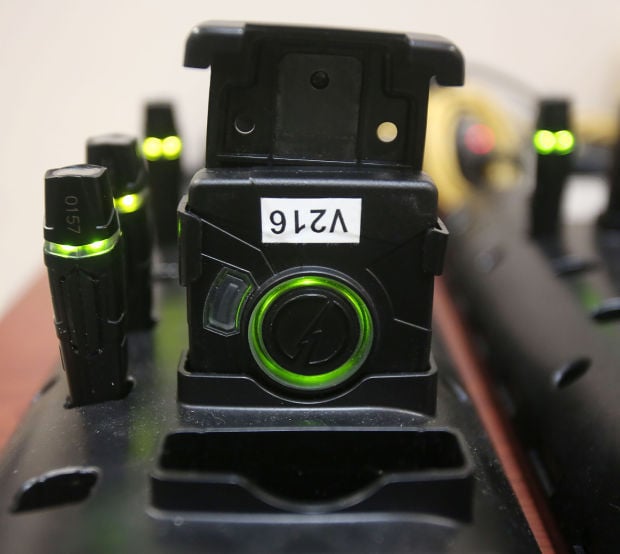The Pima County Sheriff’s Department will soon be equipped with body-worn cameras after the Board of Supervisors approved a $26.6 million contract to fund the devices Tuesday.
The money will be dispersed over 10 years in a contract with Scottsdale-based Axon Enterprise Co. to provide body-worn cameras to every deputy and corrections officers, as well as new Tasers and video storing services.
Sheriff Chris Nanos hopes to have the cameras on deputies by Jan. 1 after the department receives 800 body cameras and 800 new Tasers. The department has 476 deputies and sergeants and 417 corrections officers.
Nanos pushed for body-worn cameras in his election bid for sheriff last year and said the contract approval is a huge step for transparency within the Sheriff’s Department.
“I don’t know how much more transparent you can get,” he said. “There may be other things going on that need to be explained, but for the most part, here’s what the deputy’s seen, and you get to react just as the deputy would.”
The new cameras will have a livestreaming feature that automatically begins streaming to a supervisor and any deputy within a 30-foot radius when a gun or Taser is drawn, according to Nanos.
“When these critical incidents occur we will be able to as best we can say exactly what was confronting the deputy or the corrections officer at that moment in time,” Nanos said.
As the Sheriff’s Department builds up the infrastructure to deploy the cameras, such as equipping patrol cars with Wi-Fi, it’s also drafting policies surrounding the use of body-worn cameras.
Nanos said he couldn’t reveal those draft policies as they’re still being developed, but the Board of Supervisors was able to review them before approving the contract.
Supervisor Rex Scott previously expressed concern about how the policies would handle the release of body camera footage to the public, but said Tuesday, “I feel that the current draft policies are both comprehensive and well-crafted.”
The sheriff said the release of body camera footage will be worked into the department’s critical incident team where other law enforcement agencies in the area investigate use-of-force incidents before footage is released.
“When this incident occurs, if it’s my team that’s done the shooting, we will be a part of the investigative process, and we will not lead it and it will be handled by one of the other agencies, they will be the lead on that,” Nanos said. “Releasing to the public is going to be a pretty simple thing for us.”
As the only law enforcement agency in the county without body-worn cameras, Nanos reasoned it took so long to deploy the resource because “the technology was just being developed” in his previous one-year stint as sheriff in 2015.
“There were a lot of questions about its use and how it would work in times past. We’ve now seen over the last two years all these incidents that said this is a necessary tool,” he said. “I remember, at the time, we were thinking, ‘I know I need Tasers or I need a piece of equipment, but I also need this, so where are my priorities?’ Today, the priority is definitely body-worn cameras.”
The Sheriff’s Department is also getting new Tasers, which Nanos said he decided to include in the county’s contract with Axon after Daunte Wright was killed in Minneapolis when an officer said she mistook her gun for a Taser and shot him.
“I need my deputy or my CO to know there’s a definite difference visually of that Taser and a gun,” he said. “Plus, a lot of our Tasers were at the end of life, they needed to be replaced anyway.”
Supervisors Sharon Bronson and Steve Christy brought up concerns that no grants were funding the $26 million contract, and as of now, the new equipment will be paid for with taxpayer dollars.
Nanos said the Sheriff’s Department did look into grants available through the U.S. Department of Justice but found “those grant funds have been reallocated to other things.”
“I would hope that if a grant comes up, we can step in and say we need this grant for this and hopefully pay for some of that cost,” Nanos said.
South Houghton Road and all four Interstate 10 ramps connected to it will be closed the night of Sept. 15 before a new temporary traffic interchange is unveiled.
The I-10 ramps and Houghton Road between East Mary Ann Cleveland Way and East Brekke Road will be closed from 10 p.m. to 6 a.m. starting the night of Sept. 15, according to the Arizona Department of Transportation. The area will reopen around 6 a.m. on Sept. 16 and traffic will move on both sides of the median on the Houghton Road bridge.
The new temporary traffic configuration is part of the overall work being done for the Houghton Road-Interstate 10 project that will feature six lanes of traffic and new paths for pedestrians and bicyclists.
ADOT plans to switch traffic to the "diverging diamond" design this fall and the interchange project, which began in August 2020, is set to be completed by the end of this year. Drivers are advised to be careful and slow down when driving through the work zone on Houghton near I-10. Video courtesy of the Arizona Department of Transportation.





